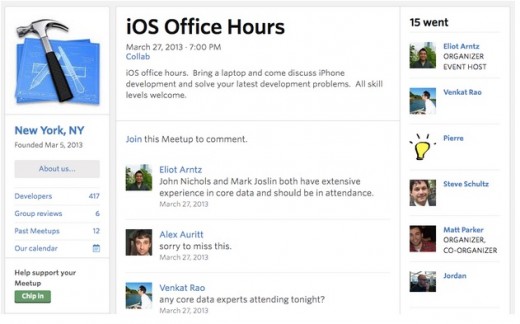
This post comes from Conrad Wadowski, Co-Founder at Fedora and TNW Academy Instructor who teaches Profitable Course Idea (free for now).
In 2014, John Azzi and Eliot Arntz started a side business that grew from a part-time operation to $2 million in sales.
When they started a little over a year ago, neither had any idea they’d be teaching full time. After all, they didn’t have any formal training in their subject, or expertise in teaching or online marketing.
They also didn’t have any special insight to work from – or know others who’ve learned how to create a teaching side business. Instead, they created their own playbook.
Despite the start, about one year after starting John and Eliot had reached over 100,000 students teaching iOS and other topics. All along the way helping their students create apps and land jobs.
So how did these two take their dream of building a successful business while traveling the world a reality?
While it started as a side business, John and Eliot did three things I’ve seen successful teacher entrepreneurs do: test their ideas quickly, grow their email list, and give something valuable away for free.
Let’s explore three ways to start or make your own side business a success. While this focuses on teaching, the same lessons can be applied to a product of any type.
Step 1: Quickly Test Your Idea
A great course is like any other great product. Instead of treating it as a bunch of features or “information,” John and Eliot and the best course creators I’ve studied think, “How does my course solve an urgent and painful problem for someone specific” and how can they test that as quickly as they can.
Once you become an expert on your customer, you can mould the course to exactly meet their needs. Once you know the exact outcome your student really wants, your job is just to make the outcome you’re promising clear in all of your messaging.
If you do this, the marketing side gets much MUCH easier. Every promotion you do naturally gets shared more. Your course becomes a kind of machine: a student enrolls expecting results, they do the things you tell them, and they walk out with the outcome.
John and Eliot’s company grew their first email list of 1,000 loyal users without some huge marketing plan. Instead, they hustled. You’ve probably heard of Eric Ries’s minimum viable product? John and Eliot did something similar – they created a minimum viable course.
After finishing the consulting work for their dev shop in the day, they put together an effort designed initially just to help them with hiring. They put up a monthly Meetup called “iOS Office Hours” in New York City where they’d meet anyone to walk through specific problems they were facing trying to learn iPhone programming.
This office hours wasn’t some full on production, it was something done in their extra time. Although John and Eliot didn’t know it at the time, this small investment gave them a deadline to start teaching, and got them to learn about what their soon to be students really needed.
After a number of students started finding the meetup, John and Eliot learned iPhone development was not only in demand but it was challenging to learn despite the many free resources available online. This helped them realize, if they wanted to create a course, it needed to be comprehensive and offer support.
Then, instead of going all out and actually creating a course, they did something entirely different – they pre-sold their first course. What better way to really test if there’s demand for your course that people pre-pay you to develop it?
And it worked. Their offer to create the best course to get someone from a beginner to a junior level developer for iPhone programming was compelling and fit neatly into an urgent need. They knew they could put their consulting work on hold while they built the full course.
2. Build Your Email List
While the first teaching sessions Bitfountain, the name of John and Eliot’s company, held weren’t yet courses, they provided an obvious value that Bitfountain capitalized on by asking students they coached for their email address.
By providing value and gathering email addresses from their coaching and personal network, John and Eliot had an audience of a 1,000 people who cared about them and helped share or even purchase the first course they released.
Once they exhausted their own contact list, they got started on growth hacking to keep building their email list. Eliot had a great story about how he got into iPhone development. He’d quit his job in accounting to join Bitfountain and learn iOS, so he posted and linked back to their course:
To show off their expertise even more, they started answering questions on Quora and at the end of each helpful answer they’d point to their online course and email list as another resource.
While, you’ll notice Bitfountain’s Twitter following only has around 4,000 followers, today their email list sits at over 100,000 which they’ve continued to focus on growing. While having a Twitter, YouTube, Facebook or any other social following is great, their email list was the most direct path to their audience.
3. Give Something Valuable Away for Free
Getting their first 1,000 customers set them up for success, but getting to 100,000 took a more dramatic approach. They needed to create a stronger incentive to get folks who were somewhat interested to get on their email list.
The first way Bitfountain tested this, was to give a gift. When Bitfountain hit 1,000 loyal users, they created a Christmas coupon code to allow them to gift their course to one person. This led to a 30 percent growth in potential customers.
Knowing how powerful this approach was, they moved on to another strategy that was more drastic and timely. You see, bitfontain’s big iOS7 course, was soon going to be outdated by highly anticipated iOS8 update which promised to make programming on the iPhone much more approachable.
At this point they’d already been developing a course for iOS8, they knew building a list of people who were very interested in iOS7 would be incredibly valuable for it’s launch. So a few months before the launch of iOS8, they took their most valuable class – which at this point included over 50 hours of programming content and sold for $499 – and made it completely free.
The effect was dramatic and took on a life of it’s own. Bitfountain’s course quickly hit the top of the online communities where their users hung out like ProductHunt, Reddit and Hacker News. The course went even further to getting leaked onto deal sites and blogs, and grabbing the attention of blogs like Techmundo and Gizmodo.
Because the course fit the audience like a glove, over 50,000 people had ended up signing up for it once the promotion was over.
Your Own Teaching Side Business
While these steps apply to any growing business, from what I’ve seen studying the space, I predict John and Eliot are just two of an emerging class of online teaching entrepreneurs.
While Bitfountain’s progress in teaching mobile programming is remarkable, many others are starting small to create profitable side businesses on subjects they’re passionate about – from watercolor painting to growing medical marijuana.
If you want to really dig into how you can get started doing the same, sign up for Million Dollar Instructor, the latest course that’s exclusively on TNW Academy. Here, you’ll learn first hand from John and Eliot, and 10 other leading course creation experts how to develop, test, and market an online course.
Read Next: What I learned from losing $1.5m and sacking 100 employees
Get the TNW newsletter
Get the most important tech news in your inbox each week.







